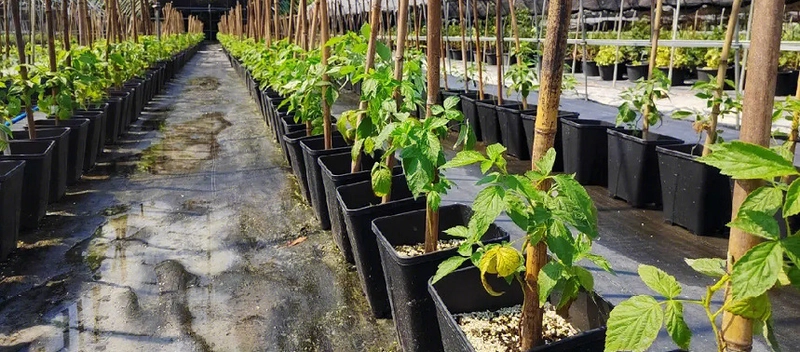Growing raspberries in pots is a practical and rewarding way to enjoy fresh, homegrown berries even if you have limited space. Container-grown raspberries allow gardeners to control soil conditions, minimize diseases, and extend the growing season. Whether you have a small balcony, patio, or greenhouse, this method provides flexibility while still producing an abundant harvest. This guide will take you through every aspect of growing raspberries in pots, from choosing the right container to maintaining healthy plants and maximizing your yield.
- Why Grow Raspberries in Pots? Raspberries are traditionally grown in garden beds, but they adapt well to container gardening for several reasons:
Space Efficiency: Ideal for urban gardens, patios, and balconies.
Soil Control: Containers allow you to maintain optimal soil conditions for raspberry growth.
Disease Prevention: Growing in pots reduces the risk of soil-borne diseases.
Mobility: You can move the containers to optimize sunlight exposure or protect plants from extreme weather.
Extended Growing Season: In colder climates, you can move potted raspberries indoors to extend their fruiting period.
- Choosing the Right Raspberry Variety Not all raspberry varieties are well-suited for container growing. The best choices are compact and self-supporting varieties, including:
Everbearing (Fall-bearing) Raspberries: These varieties produce fruit on first-year canes and are ideal for continuous harvests. Examples include:
‘Heritage’
‘Autumn Bliss’
‘Joan J’ (thornless)
Summer-bearing Raspberries: These varieties produce fruit on second-year canes, offering a single large harvest in summer. Examples include:
‘Tulameen’
‘Malling Jewel’
Dwarf Varieties: Specifically bred for containers, these varieties are smaller but still highly productive. Examples include:
‘Raspberry Shortcake’ (thornless and compact)
- Selecting the Right Container Choosing an appropriate container is crucial for healthy raspberry plants. Here’s what to consider:
Size: A pot should be at least 16-20 inches in diameter and 12-16 inches deep to accommodate root growth.
Material:
Plastic pots retain moisture but may overheat in full sun.
Clay or ceramic pots provide breathability but dry out faster.
Fabric grow bags offer excellent drainage and aeration.
Drainage: Ensure the pot has several drainage holes to prevent root rot.
- Best Soil for Potted Raspberries Raspberries prefer slightly acidic, well-draining soil with plenty of organic matter. The ideal soil mix includes:
60% potting soil (high-quality, loamy soil)
30% compost or well-rotted manure (adds nutrients)
10% perlite or sand (improves drainage)
pH Level: Aim for a soil pH of 5.5 to 6.5. If the soil is too alkaline, add sulfur or peat moss to adjust it.
- Planting Raspberries in Pots Step 1: Preparing the Pot Place a layer of gravel or broken terracotta at the bottom to improve drainage.
Fill the pot with the prepared soil mixture, leaving about 2 inches of space at the top.
Step 2: Planting the Raspberry Cane
If planting bare-root raspberries, soak the roots in water for 1-2 hours before planting.
Dig a small hole in the center of the pot and spread the roots evenly.
Cover the roots with soil, ensuring the crown (where roots meet the stem) is just above the surface.
Firm the soil gently around the base and water thoroughly.
Step 3: Positioning the Pot
Place the container in a sunny spot with at least 6-8 hours of direct sunlight daily.
If growing indoors, position the pot near a south-facing window or use grow lights.
- Watering and Mulching Watering Raspberries in pots dry out faster than those in the ground.
Water deeply whenever the top 1-2 inches of soil feels dry.
Avoid overwatering, as soggy soil can lead to root rot.
Mulching
Applying a 2-inch layer of mulch (straw, shredded leaves, or bark) helps retain moisture, suppress weeds, and regulate soil temperature.
- Fertilizing Potted Raspberries Raspberries are heavy feeders and require regular fertilization:
Early Spring: Apply a balanced fertilizer (10-10-10) when new growth appears.
Flowering and Fruiting Stage: Switch to a high-phosphorus fertilizer (such as 5-10-10) to promote fruit development.
Organic Options: Use compost tea, fish emulsion, or aged manure for a natural nutrient boost.
- Supporting and Pruning Raspberries in Pots Providing Support Most raspberry varieties benefit from support to keep canes upright. Options include:
A small trellis or stake inserted into the pot.
A tomato cage for dwarf varieties.
Pruning Raspberries
Everbearing raspberries: Cut all canes to ground level in late winter or early spring for a single large fall harvest.
Summer-bearing raspberries: Remove only the old, fruited canes after harvest, leaving the new ones for next season.
- Managing Pests and Diseases Common pests and diseases that affect raspberries include:
Aphids & Spider Mites: Wash them off with a strong water spray or use insecticidal soap.
Japanese Beetles: Hand-pick them and drop them into soapy water.
Powdery Mildew: Ensure good air circulation and avoid overhead watering.
Root Rot: Prevent by ensuring proper drainage and avoiding waterlogging.
- Harvesting and Storing Raspberries When to Harvest Raspberries ripen in midsummer to fall, depending on the variety.
They are ready to pick when they easily detach from the plant and have a deep, rich color.
How to Harvest
Gently pick berries in the morning when they are cool and firm.
Handle them carefully to avoid crushing.
Storage Tips
Fresh consumption: Store in the refrigerator and consume within 2-3 days.
Freezing: Spread berries on a tray, freeze them, then transfer to a sealed bag for long-term storage.
- Overwintering Potted Raspberries In colder climates, protect your raspberry plants from winter damage:
Move pots to a sheltered location, such as a garage or greenhouse.
Insulate pots with bubble wrap, burlap, or straw to protect roots from freezing.
Water sparingly in winter to prevent root dehydration.
- Conclusion Growing raspberries in pots is a fantastic way to enjoy fresh berries even in small spaces. With the right container, soil, and care routine, you can achieve a bountiful harvest season after season. Whether you are a beginner or an experienced gardener, following these steps will help you cultivate healthy, productive raspberry plants right on your patio or balcony.

Naturehydro Rasberry Grow
info@naturehydro.com
https://www.naturehydro.com

